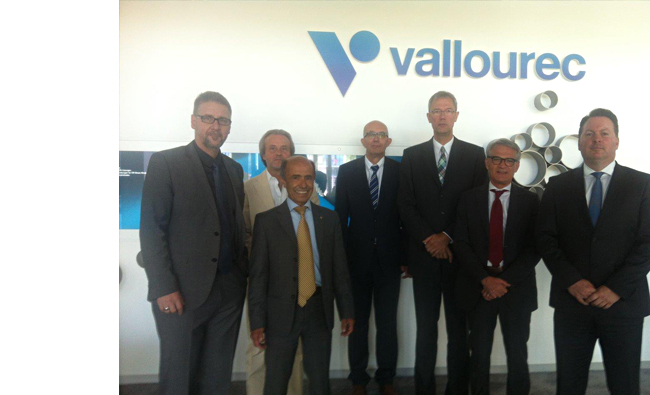
3-roll Cross Rolling Mill (CRM) at Vallourec Deutschland
The newly designed unit to replace a Mannesmann Cross Rolling Mill in the Düsseldorf-Rath Pilger Complex (among the world's biggest of its kind) is a unique equipment, expressely developed for this special application and currently not installed in any other plant in the world.
On 30th June 2015, Vallourec Deutschland reaffirmed again its trust in Danieli Centro Tube process technology and complex project execution construction capabilities awarding the order for a Cross Rolling Mill that matches Vallourec’s outlook for the future in terms of a larger production range –both for tube sizes and material quality-, improved geometrical tolerances, and lean productivity cycles.
The CRM will be installed between the vertical piercing press and the pilger mill and will be used to elongate the pierced hollows. Special care will be taken in the design since the installation is taking place within the existing old facilities.
Steel grades included in the Düsseldorf-Rath Pilger Complex production programme are carbon, micro-alloyed, medium- and high-alloy, austenitic qualities, special steels with up to 13% Cr, and nickel-based alloys, used for a wide range of applications for extreme service conditions (e.g. boiler tubes, tubes for petrochemical applications, cylinder and pressure vessels, oilfield tubulars (casing and tubing), line pipe, etc.
The process starts once the pierced hollow has reached the punching machine, where removal of the hollow bottom part is taking place, and then continues by transferring it to the CRM entry where the outside diameter, wall thickness and length is rolled in relation with the requirements of the pilger process steps downstream of the CRM.
In the 3-roll CRM process, the hollow is formed by means of three barrel-type rolls – arranged at an angle of 120° - and arranged symmetrically around the tube axis, and by a plug. Each roll is individually driven and equipped with two hydraulic capsules.
During the elongation process, the rolls rotate in the same direction and act like a gear together with the rolling material placed at the centre. The inclined position of the rolls creates a spiral movement. The plug, which is held by the plug-bar with the help of the thrust block on the outlet side, absorbs any horizontal forces arising.
As soon as the rolling operation is over, the elongated hollow is moved, through a rollerway, to the inline descaler installed at the end of exit section. By overhead crane it is then transferred to feed the pilger mill.
Process controls are carried out through an up-do-date automation system supplied by Danieli Automation, including Lev.1 and 2, which are interfaced together through a common communication network for an integrated and effective plant supervisory control system.
Further to mill stand and drive components, the scope of supply includes all auxiliary equipment, namely: horizontal punching machine to remove the pierced hollow residual bottom, hollow transfer car at the inlet of the CRM, pusher and inlet trough, roll cartridge and relevant changing equipment, complete outlet area, in-line descaler, hydraulic and lubrication units, electrics and automation, toolings.
Additionally, Danieli’s scope of work also includes various services such as in-house testing of equipment, training of operating personnel, dismantling of existing equipment and execution of new foundations suitable for the installation of the new equipment, complete installation (mechanical, electrical, hydraulic…) of the new equipment, commissioning and startup.
As for previous projects carried out within the fruitful collaboration between Vallourec and Danieli, a strict framework of cooperation has been established between these two companies’ teams to guarantee smooth and successful execution of the project with the goal of achieving all the contractual milestones related to quality, time schedules, and CRM mill performances.
a relatively short time-frame has been assigned to the Project development in order to execute all site activities -from existing equipment dismantling to new equipment installation and up to production restart- between the end of November 2016 and end of January 2017.
